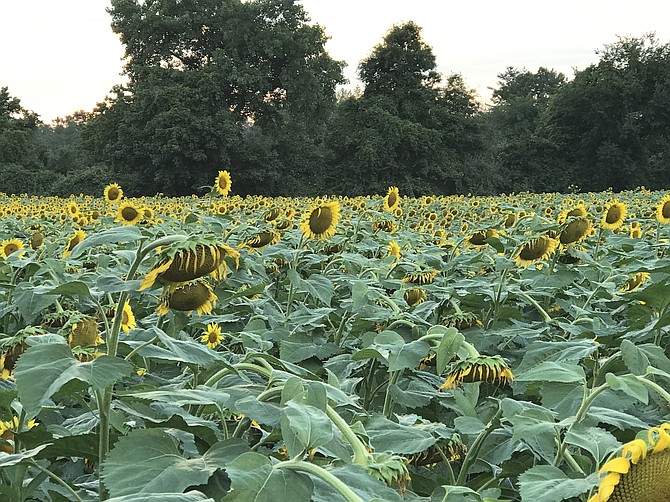Acres of sunflowers attract birds, bees and photographers. With favorable conditions, the sunflowers will bloom in mid-July. Almanac file photo
The Maryland Department of Natural Resources - Wildlife and Heritage Service plants sunflowers each spring on the McKee-Beshers Wildlife Management Area (WMA), creating fields of potential Instagram posts. The primary purpose for planting sunflowers on wildlife management areas is to provide a food source for mourning doves, as well as other wildlife species, after the plants mature and dry. Mourning doves are hunted at these fields during hunting seasons that traditionally begin on September 1 and continue through early January.
A number of fields are planted each year, although two fields are designated as Dove Management Fields. These fields are located on River Road, east of Hunting Quarter Road, and on the corner of River Road and Sycamore Landing Road. The Dove Management Area fields have restricted times and days when hunting can occur during the month of September.
In addition to mourning doves, sunflowers and sunflower seeds are a favorite food source for a host of other songbirds, mammals and pollinators. Sunflowers require pollination by insects, usually bees, to produce a seed crop. In turn, honey bees and many species of native bees, benefit from the abundant nectar and pollen that sunflowers produce.
The many benefits of sunflowers are lost when they are cut or trampled by people. These sunflowers are planted for the benefit of wildlife and regulations prohibit the cutting, destruction or removal of any plants from these areas.
The public is welcome to visit, admire and photograph the sunflowers in bloom. However, visitors must be responsible and ensure that their actions don't have negative consequences.
McKee-Beshers Wildlife Management Area may be accessed any time of day with no overnight camping allowed. There is no fee or permit required to access the property.
Dove Management Areas are funded with hunting license fees and Federal Aid in Wildlife Restoration Funds, commonly known as Pittman–Robertson funds. Pittman Robertson funds come from a federal excise tax on sporting arms, ammunition, archery equipment and handguns. These funds are collected from the manufacturers and are distributed each year to the states and territorial areas by the Department of the Interior.
Non-hunters interested in contributing financially to these sunflower fields may purchase a Maryland Migratory Game Bird Stamp. You do not need hunter education or a hunting license to purchase the stamp. The stamp is available online through COMPASS or at any location that sells hunting licenses. https://compass.dnr.maryland.gov/Security/Logon
How and when they are planted:
The techniques used to plant the sunflowers, and the sunflower variety planted, may change from year to year, as well as the number of acres planted and their locations. Sunflowers are planted in late April or early May. Weather, seed variety, weed competition, soil condition and herbivore damage will all impact the time that it takes for the plants to bloom. With favorable conditions, the sunflowers will bloom in mid-July.
After the sunflowers are done blooming and seeds are mature, in early to mid-August, strips are mowed through the sunflowers to scatter the seeds on the ground where they are more accessible to mourning doves and other wildlife.
2019 Sunflowers: The 2019 sunflowers were planted on May 1, 2019. Please reference the picture below for current sunflower status.
Area Regulations:
Destruction or removal of any plants (including sunflowers) is strictly prohibited.
Parking is only allowed in designated parking areas.
Do not block gates. Violators may be towed and ticketed.
Driving is only allowed on main roads (River Road, Hunting Quarter Road, and Sycamore Landing Road). Only authorized or emergency vehicles allowed behind gates.
Dogs are allowed, but must be leashed.
Wildlife Management Areas are trash-free. No trash cans are provided. Please take all trash with you.
GPS Coordinates of sunflower fields
Field 1 (River Road) - N39.080050, W-77.374460
Field 2 (Hunting Quarter Road) – N39.079172, W-77.388253
Field 3 (Sycamore Landing Road) – N39.084146, W-77.413121
Tips for a successful visit:
McKee-Beshers WMA has no bathroom facilities, no benches and no picnic tables. Please plan accordingly.
McKee-Beshers WMA is home to ticks, mosquitoes and poison ivy. Long pants and shoes are recommended.
https://dnr.maryland.gov/wildlife/Pages/publiclands/central/sunflowers.aspx

